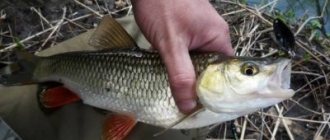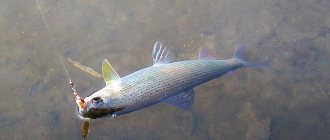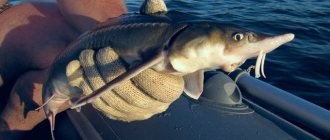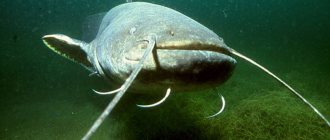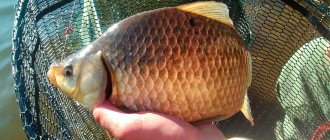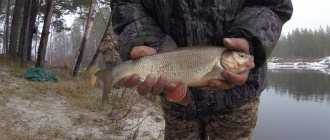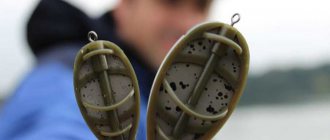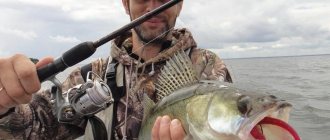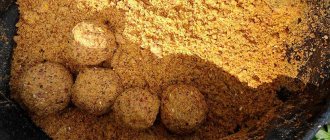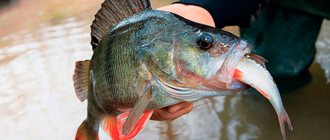Where does it live?
Habitat: Black, Baltic, Caspian Seas, Atlantic Ocean.
The barbel belongs to the category of sedentary fish. In the warm season, he prefers to stick to deep places with fast currents and a rocky bottom. Often found in direct currents, but tries to avoid pools with reverse currents. Favorite places are deep furrows with a pebble, rocky or sandy bottom.
The young generation of fish stays in small schools; they live on the rifts along with the gudgeon. Large individuals live separately. With the arrival of winter, the common barbel lies in holes and burrows under steep river banks, and the bite is practically absent.
Catching barbel in winter is ineffective.
The Crimean barbel lives in the waters of the Western Caucasus and Crimea, the Dagestan barbel lives in the rivers of Dagestan, Terek and Kuma, and the Kura barbel lives in the Kura. There is also the Dnieper barbel; in total there are 9 subspecies of this fish.
The fish comes out to feed mainly at night; the objects of its hunt are various crustaceans, worms, mollusks, all kinds of insects and their larvae. Myron does not disdain the caviar of other fish, in particular his fellow fish.
Sexual maturity of a fish occurs at 3–4 years, it all depends on the size of its body. The optimal body length is about 20 cm; it should be noted that females are much larger than males. Miron lives 14 – 18 years.
The spawning period of barbel begins in the first half of May, when the water temperature warms up to 15 degrees. Deep rocky reaches with fast currents are chosen as spawning grounds. Each female is capable of laying up to 50,000 eggs.
The spawning process occurs at the bottom, where the females attach themselves to the rocks and after 15–18 days you can observe the appearance of small barbel larvae. Various microorganisms become their food source. Considering that eggs are laid in several stages, the spawning period lasts 2 months.
Description of the fish
The common barbel is a river fish distributed throughout almost the entire territory of Eurasia. Its other names are myron, moraine, bruzhanka. The barbel belongs to the Karpov family. It has several subspecies.
A characteristic feature of the fish are two pairs of whiskers located at the corners of the mouth and head, which are used to search for food at the bottom of the reservoir.
Unlike most Carp, which live in almost any conditions, the barbel is very sensitive to the quality of water and the degree of its enrichment with oxygen. Perhaps only trout lives in cleaner waters than the moraine.
The body length of the barbel can reach up to 85 cm, but most fish rarely reach 40 cm. The average weight is 4-6 kg. The largest specimens were caught in Europe (up to 16 kg). The largest representatives from Asia rarely exceed 8-10 kg.
Important! In the Volga basin, the barbel is practically not found.
The body is relatively long, almost cylindrical in shape. In addition to the mustache, the fish is distinguished by a characteristic trunk-shaped mouth, even more pronounced than that of ordinary carp. The eyes are small, most often light brown.
The fish has a high dorsal fin located in the middle of the body. The color of the barbel is silvery and uniform. The top of the back has an olive tint, the belly is white. Some varieties have brownish spots located on the upper part of the body, above the lateral line.
The pelvic and pectoral fins are approximately the same size, the anal fin is slightly larger. The number of large rays in them does not exceed a dozen. The color of all fins is the same, but each subspecies has its own.
The fish feed on the bottom - every day the barbel goes hunting, moving, like carps, along a more or less constant route in search of food. The basis of the moraine's diet consists of mollusks, various worms, crustaceans, etc. They do not disdain plant foods.
Despite the increased caution and even timidity of the fish, barbels often behave very noisily: splashing in the water, jumping out of it, tearing the bottom, etc. This behavior is observed almost throughout the warm season, and not only during spawning.
Bream fish: photo and description
Sexual maturity occurs at 3-4 years in males and 4-5 years in females. By this time, the fish reach a length of 15-25 cm. At the same time, the behavior of the animal changes. If young animals prefer to stay in small areas with weak currents, occasionally on rifts, swimming with minnows and other small fish, then mature individuals prefer areas with fast currents, fresh and clean water. We can say that the behavior of young barbels resembles the behavior of carp, and adults - carp. The latter love rocky and deep places in rivers, occasionally appearing in shallow water.
Spawning occurs at the end of spring (May-June), when the water temperature becomes about +15°C. Females are capable of releasing from 15 to 100 thousand eggs. The fry appear after 1-2 weeks depending on the temperature. Their growth is relatively fast: in 4 months the size of young longhorned beetles reaches 10-12 cm.
Fish do not like large temperature fluctuations. They feel most comfortable at 15-25°C. Within the reservoirs in which they live, local migrations of the barbel to zones of more acceptable temperatures are observed. The lifespan of fish is about 25 years.
Since longhorned beetles need fresh running water, due to human activity, many of their varieties have become very rare over the last hundred years. The construction of dams, as well as the use of rivers for industrial wastewater, has significantly reduced both the habitat of the moraine and its abundance. Currently, there are bans on catching some species of these fish, even by amateur means.
Barbel fishing gear
There are several ways to catch such powerful and cunning fish on the river:
- For float tackle, where long rods from 5 m are used. For line fishing, the tackle is equipped with an inertia-free reel, the diameter of the main line is 0.35 - 0.4 mm, for leashes it is necessary to use a thread with a cross-section of 0.25 - 0.30 mm. To ensure that the bait passes close to the bottom, the sinker is placed at the end of the tackle, and the leashes are placed a little higher. And the second method: the intermediate sinker on the tackle and the leash with the bait must be in the bottom layer.
- For bottom tackle, where they use tackle equipped with a blind sinker, a sliding sinker and feeder rods with a feeder. A fishing thread with a thickness of 0.25 - 0.3 mm is used as a leader material, and a thread with a cross-section of 0.4 mm is used for the main line. To securely connect the main line with the leashes, use a swivel with a clasp. It is advisable to install hooks with a round eye, numbers 7 – 9.
- For spinning tackle equipped with small spinners, for example “Universal”, “Baikal”. It is more effective to fish with bait whose color is similar to the aquatic inhabitants of a particular body of water. In order for the bait to be retrieved effectively, the retrieve is carried out above the bottom. It is recommended to examine the topography of the bottom of the reservoir at different points and at different distances from the shore.
Since myron leads a bottom lifestyle, and its whiskers serve as a kind of radar in search of food, it is recommended to fish on the river with the following types of bait:
- insect larvae;
- crustaceans;
- leeches, snails;
- small fishes;
- large earthworms and dung worms;
- pieces of semi-soft cheese;
- steamed cereal grains;
- boiled potatoes;
- thickened animal blood;
- lungs, liver;
- fry;
- boilies.
In spring, fish actively bite on the livers of animals and birds.
It is especially effective to use bait mixtures when catching barbel. Like all representatives of the carp family, they prefer aromatic compositions. But don’t overdo it with flavorings; everything needs moderation. The barbel bites well on a bait mixture with a fruity aroma.
The bait should be made only from fresh ingredients and include either maggots or pieces of worms. It is enough to use five components to make the bait high quality and effective. The consistency of the mixture should not be too hard or too soft, it should sculpt well.
In reservoirs with a current, it is recommended to throw the bait mixture against the current, without unnecessary noise. Otherwise, you can scare away the object of fishing.
The most favorable time for catching barbel is considered to be the warm season. In the autumn, large barbel bites reluctantly.
https://fisher-book.ru/558-lovlya-usachahttps://catcher.fish/ekspertnyi-tsentr/fishexpert/opisanie-usacha-primanki-i-snasti-dlya-ego-lovli/
Lure
It is especially effective to use bait mixtures when catching barbel. Like all representatives of the carp family, they prefer aromatic compositions. But don’t overdo it with flavorings; everything needs moderation. The barbel bites well on a bait mixture with a fruity aroma.
The bait should be made only from fresh ingredients and include either maggots or pieces of worms. It is enough to use five components to make the bait high quality and effective. The consistency of the mixture should not be too hard or too soft, it should sculpt well.
In reservoirs with a current, it is recommended to throw the bait mixture against the current, without unnecessary noise. Otherwise, you can scare away the object of fishing.
The most favorable time for catching barbel is considered to be the warm season. In the autumn, large barbel bites reluctantly.
Equipment
Experienced fishermen most often use spinning rods as the most reliable method for catching asp. To assemble a fairly universal set for catching this fish, you need to have a long rod, preferably at least 2.7 m (length from handle to tip) if fishing takes place on a large river. The rod must be powerful and have a fast peak action to make it easier to hook fish from a greater distance, but also elastic enough to absorb the jerks of a caught asp in a fast current and safely tow even the largest specimens.
Video: Catching asp with a spinning rod
The choice of rod weight depends on the type and weight of the lures that will be used for fishing, and its upper limit should be in the range of 20–30 g, with a higher value indicated if the water level in the river is deep (50–70 g). The reel must be strong and fast, i.e., have a large gear ratio. Size is a matter of taste and individual preference of the fisherman.
The fishing line should be chosen to be soft enough and with high strength at knots with a length of 150–200 m. The optimal diameter is 0.22 mm, which will ensure fast casting and reliability even with heavy bait. It is advisable to mount with a shock leader (10 m). This piece of stronger line takes all the stress, keeping the main part intact and reducing the likelihood of breakage. A thinner main line increases casting distance. The presence of only pharyngeal teeth in the asp makes it not dangerous for the fishing line, so a leash is not needed.
Find out also how to catch chub with a spinning rod.
It is better not to use braids as the main line, as they prevent rapid immersion, and wear and fraying occurs more intensely due to frequent casting and winding onto the reel. Such a fishing line (even a thin twist) is better visible in the water, and the asp is a fish with keen eyesight.
Catching barbel on a donk (feeder)
Fishing with tackle with both a blind and a sliding sinker is successfully practiced, plus the option with feeder feeders. The diameter of the fishing line for making leashes is 0.25-0.3 mm, for the main one – 0.4 mm. It is optimal to connect the leashes to the main line using swivels. Hooks - No. 6-7, with round eyes.
The traditional rod for hunting barbel is the heavy feeder type.
The fish most often bites very sharply and hooks itself, so it is important to secure the fishing rod well so that the barbel does not simply drag it into the water. . Red worms in bunches, large crawlers, and pieces of hard cheese are used as baits for deep barbel fishing.
At night, barbel fishing is more productive than during the day.
Red worms in bunches, large crawlers, and pieces of hard cheese are used as baits for deep barbel fishing. At night, barbel fishing is more productive than during the day.
Large boilie-type baits are used on hair rigs. In any case, hooks should be selected taking into account the size of the nozzle.
Read Which reel is best for spinning for pike
It is acceptable to use both monolithic and braided fishing lines for leashes. In the case of fishing line, the breaking load should be about 4 kg, for braid – 6 kg.
Part of the main bait must be added to the bait mixture. To fix the feeder, it is also better to use swivels with clasps; the knots are protected by a small rubber bead.
Usachi Kuban
Photo from the editorial archive
Considering the relatively little coverage of some topics in modern fishing publications, it seems interesting to tell readers about fishing for barbel in the middle reaches of the Kuban River.
Barbel Miron is a common fish for the river. Kuban and other large mountain rivers of southern Russia. The upper reaches of the barbel do not live in cold and fast waters, as well as in the lower reaches. For him, a comfortable habitat is the middle part, where the water is warm but relatively cold, and there is a lot of food. There are more than 400 types of fish dishes here. Perhaps for this reason, many southern anglers cannot catch barbel or sometimes catch undersized ones. The true barbel is a torpedo-shaped, powerful creature adapted for living in fast and deep waters. The resistance of a barbel and the force it develops in a jerk exceed the corresponding indicators of a wild carp of equal weight. The usual weight of a very strong and fast-moving barbel is 2-3 kg, which corresponds to a wild carp weighing 4-6 kg.
Longhorn beetles also live in small mountain rivers in southern Russia, but, as a rule, in the lower reaches with a pebble or stone bottom. Even on the border with Abkhazia, in the Mzymta River, barbel has always been a common fish. And the Terek barbel is common in the rivers of Dagestan - in Kum and Teran. The barbel is also found in the rivers of Western Transcaucasia.
This fish is crepuscular, but mostly nocturnal. Just like fishing for bream, which bites better at night, it is also planned to catch barbel on bottoms. Kuban fishermen have not used feeders before, probably relying on high results from the use of a bait in the form of a mayfly larva, from a large number of donks, a relatively high density of barbel in the river and, of course, from the lack of competitors.
Now about the timing of catching myron-barbel in mountain rivers. From mid-April to mid-August, huge masses of fast, muddy and high water flow along the beds of mountain rivers, where, it seems, there is no one to live and peck, including the barbel. After the water recedes, the medium-sized barbel immediately begins to eat in the daytime. In a good place, using even two donks is overkill, since small fish often rip mayfly larvae off the hooks with impunity, unlike a large barbel pecking at the mouth. You understand this when you look at the small mouth of a fish. Then you begin to consciously use small, strong hooks. And you try to get as many mayflies as possible... True, in the spring the barbel willingly bites on large earthworms. In summer, maggot, cheese, wheat grains, and crayfish are suitable. There were successful experiments using dragonfly and chafer larvae, and pieces of crawling beetle. The best fall baits are mayfly larvae and... live bait. In the fall, bottom fishing for small baits using a spinning rod is also quite appropriate. But it seems that a feeder full of processed cheese and 6-7 maggots on a hook is the angler’s optimal approach to catching barbel of any size and weight from spring to autumn, if you forget that the high summer rise in water can instantly ruin any good fishing plan.
During the day, barbel is not caught in random places on the river, like other fish. Therefore, only running fishing is effective in mountain rivers. Sometimes you walk along the river bank for 7-10 km, choosing a river loop for fishing that returns you almost to the starting point.
In well-studied places, barbel bite can be expected in any season, if the river has not changed its bed beyond recognition. Thus, sand spits are easily transported by the river to another place. The blockages of trees that formed in the coastal stream under the steep banks, where large myrons regularly pecked for several seasons in dangerous proximity to the blockage, are also disappearing somewhere. In one day a river can cover a gravel coastal spit with silt, where the depth is about three meters, the flow is smooth and even. Here, too, for several seasons, myrons regularly pecked near a huge weeping willow.
Anatoly GogolevJuly 1, 2014 at 00:00
Epiphany on the river
One day my colleague Maxim and I were fishing on the Kuban River. Maxim caught a barbel with a floating wobbler, while I had to settle for a small chub with a feeder tackle. At first, I puzzled over why the barbel rejected the maggot and took a wobbler - an imitation of a small fish. It dawned on me when I saw a lot of white fish fry that were just offshore. They formed an ideal food base not only for predators, but also for large non-predatory fish. And it is precisely the large barbels that, apparently, more often than fishermen think, feed on young fish. When white fish spawn, barbel feed on the larvae hatched from the eggs.
Catching barbel in mountain rivers
In many places in mountain rivers trout are caught next to barbel. Wandering around in search of barbel hiding spots and then catching one is great fun.
In the foothills, the river forms breaks and various banks, but still has a rushing stream and crystal clear water.
Boulders.
You need to find a flat strip of bottom along large boulders, away from the main stream. Feed with large balls of tightly glued food. Buoyancy additives such as oatmeal or cracked corn should be included. By selecting such food, the barbel will stay on the side of boulders for a long time. The loaded float tackle is thrown 2 m in front of the boulders; the bite can occur right at the feeding site. If possible, the rig should go several meters below the boulders. If the current is weak, a float of up to 3 g, a sinker of 2 g, and a 1/4 weight of the float are sufficient. In another case, the load is changed by 1/3 and fixed with a sinker.
Depression.
Prepare heavy balls of bait with the addition of clay.
There are always a few barbel hanging around the entrance to the hole, so it's a good idea to start fishing at this point. The bait is thrown 2 m before the depression due to the current. They also throw loaded tackle. They bring it up to half the length of the depression and imperceptibly pull it along the shore. If there is no bite, then reduce it to half the length and cast the bait again. They fish the depression along with shallow water. Here, at the end of the wiring, a small and light hook is made. As a rule, a float of 2-5 g, a sinker of 1.5-4.5 g, and a weight of 1/4 are sufficient.
Fishing on a mountain river
Main flow.
It is advisable to find a place in the main flow where it weakens a little and becomes shallow. For fishing they use a Bolognese fishing rod and bait.
If the depth allows, the first large part of the food can be brought to the fishing site, and the next one can be shot with a slingshot. Need to feed often.
A float with a thick antenna is used, and the load should be equal to half its buoyancy. Throw the tackle 3 m from the location of the bait.
You need to hook when the float dives under the water, or intuitively.
Ways to catch barbel.
From a sporting point of view, the barbel is of interest to any angler, because it is strong, agile and alert, careful and cunning. Where fishing is permitted, you can use float rods and bottom gear - ordinary and with a sliding sinker. For fishing with a fishing rod, choose deep places - holes or deepened river beds below the rifts, especially where reverse currents and whirlpools form.
A characteristic feature of the behavior of barbels in rivers is that they like to noisily jump out of the water at dawn, making very high jumps.
The gear for catching barbel must be strong: an elastic rod should be chosen no shorter than 5 meters, the main line is 0.3-0.4 mm, the leash is 0.2-0.25 mm, hooks No. 6-7.
Donka is one of the most popular gear for barbel fishing. In those distant times, when the barbel was not yet so oppressed by human economic activity and was found much more often than now, I caught this fish using several successful variants of the donkey - there was one for each time of day. An ordinary donka, with 3-5 leashes, each 25-30 cm long, with an end sinker of such weight that it does not get carried away by the current, is best used during the day and at dawn.
It is better to use a donka with a sliding sinker at night and at dawn. It looks like this: the sinker moves freely between two stopper knots on the main line, to the end of which two leashes are tied - one 40 cm long, the other 50 cm. The knots are knitted in different directions so that the leashes do not get confused with each other.
Barbel is a nocturnal fish and, as a rule, at this time of day it comes close to the shores, so for night fishing 15 meters of fishing line is quite enough, for daytime fishing you can make the tackle longer.
All donkeys are equipped with a main line of 0.6-0.7 mm, leaders of 0.4-0.5 mm, hooks No. 8-10 - forged with a medium-sized shank. In all cases and for all gear, worms can be used as bait - dung worms, subleaf worms and crawling worms.
Small worms are baited onto the hook in a bunch, and large worms are baited one at a time, leaving a small tip.
The barbel fishes well on the meat of barley shells and crayfish, and on insect larvae.
In summer it goes well with cubes of soft and viscous cheese. If the pieces are hard, they should be kept in milk, or warm. The barbel's menu includes boiled potatoes and steamed cereal grains.
A very good bait throughout the season is the blood of animals, for example, sheep, kept for a day or two in a cold cellar. Once it has hardened, it can be cut into cubes to fit the size of the hook. By the way, this bait is used by all types of cyprinids and even predators - burbot, perch, pike perch, bersh, nosier ruff, etc.
It takes large barbel very well on fry, sometimes even better than on some other baits. It bites sharply and is often caught on the hook itself.
When fishing, the barbel resists in the most desperate way: in order to free itself from the hook, it makes sharp throws in different directions and, if there is a snag, a large stone, bottom protrusions or other shelters nearby, it, as a rule, saves itself under them. Therefore, you need to know the reservoir well and not fish in such unfavorable places - this fish has a lot of tricks.
After the rains, barbels come close to the shores, looking for food, and then a good bite is observed. The same thing happens after spawning. Considering that barbel are more sedentary fish, you should change fishing spots more often.
Pollution of our water bodies with toxic chemicals and other harmful discharges has led to a serious decline in the number of barbels, since this fish loves clean, cool water.
It is known that the barbel is included in the Red Book of Belarus. It is possible that similar measures have already been taken in other CIS countries. Therefore, before you go fishing for barbel, find out what the rules are for catching it in the body of water you have chosen.
The barbel is a very tenacious fish; in wet grass it can be freely brought home alive. The meat is quite tasty, it is especially good when fried, and even better when smoked. Aral barbel balyk is rightfully considered a delicacy.
Read Salapin porridge - recipe
Where to fish
Freshwater bodies of water with muddy water in the early and evening hours.
According to information from the network, the barbel most often bites from spring to autumn.
From personal experience, in Israel, given the hot climate and warm winter, the most active biting time for me was in the spring from March to May; I caught barbel throughout the summer. It was least common to catch barbel in the fall, approximately from the second half of September to November. Unfortunately, the frequency of fishing trips leaves much to be desired, and there are no more detailed statistics yet. If anyone can share more specific data on barbel biting times in Israel, I would be very grateful.
The ideal time is after the rains, during the rains, since at this time the barbel comes close to the shore to eat worms washed by the rain. His element is muddy water.
It is not recommended to go hunting in anticipation of inclement weather and during the spawning period, during which time the fish ignores the bait.
On a clear early morning or late evening, using a float tackle would be ideal, but a bottom rod is best used at night.
The most common fishing spots:
- area of rapids with a shallow depth of up to a meter;
- deep-sea backwaters;
- places with little current or reverse current;
- bridges;
- piles;
- mouth
The shallow waters of the Jordan River are an ideal place to use a fly rod equipped with thick fluorocarbon line, the use of which reduces drop-offs and makes it invisible in muddy water.
The use of sliding, spiral-shaped feeders, on both sides of which weights are attached. The weight of each load depends on the degree of current. The main thing is to ensure that the bait does not rise to the surface of the water and that the bait is easy to wash out. Next, secure the fishing hook.
Another option for equipping a spinning rod:
- fishing line (the strongest, for example, braid);
- heavy weight;
- leashes 20 cm long;
- hooks No. 6 or 7, on which a folded crust of white loaf bread is attached.
Advice: in order for the bait to last as long as possible, it should be placed in bags that are tied to a long stick. Secure the stick in the fishing spot, so the bait will not be carried away by a strong river current.
Advice:
- use bright baits to attract fish in troubled waters;
- use weighted nozzles in strong currents like in the Jordan.
Animal attachments:
- dung worm (earthen, crawling);
- pieces of beef or heart;
- cancerous cervix;
- pieces of crayfish meat.
Plant attachments:
- mulberry (used in summer, when the tree falls off, in the area where the upper reaches of the Yardenka River are used);
- pearl barley;
- dough (maybe pilot dough);
- soft porridges;
- a crust of white bread.
They also use an unconventional bait - French hard Parmesan cheese (or another type of hard cheese), necessarily moistened until soft (in a wet rag or milk), which will ensure ease of installation on the hook. The advantage of such a nozzle is the strength of its hold on the hook.
It also happens: How a garfish bites
You can also use pieces of fried lard. The disadvantage of using them is that they quickly saturate the fish.
Advice:
- the hook must be completely filled with bait;
- Non-traditional baits are used when the current is not large, since they are not firmly attached to the hook.
5.7 How the barbel bites
The bites are cautious, so you should use sensitive gear. To prevent the barbel from tearing off the bait, it should be hooked immediately after the bite. If the tackle is not soft, then the hooking should be smooth to avoid breaking the line.
When catching a large specimen with a donk, the hooks are noticeable. The resistance is daring and aggressive, the barbel rushes against the current and if the rod is without a reel and with a weak line, as a rule, it breaks.
When fly fishing, the bait is cast against the current, and when using a feeder, the cast should be careful and in the direction of the current, so as not to frighten off the cautious barbel.
- have a landing net with a long handle;
- observe weather conditions;
- have strong gear.
Below are some free fishing spots on the Jordan River in Israel. I have personally been to each of them, and I know that there you can catch not only barbel, but also Jordanian catfish (here you can read how I caught catfish), mullet, carp and even eel. Each of these places is good in its own way, and which one you choose is up to you.
Taking into account the way the barbel feeds and the conditions at the fishing site, the bait is applied with fairly frequent, strong and prolonged slowdowns. This wiring method is a middle ground between semi-stationary fishing for bream and active wiring of equipment when fishing for ide. After all, a feeding barbel not only lifts the bait from the bottom, but also grabs pieces floating at depth.
When fishing with a “running” rig at a long distance, the rig is carried out almost without braking. The depth should be set so that the main sinker floats above the surface of the bottom, and the bait drags along the rocks. The barbel bite is strong and confident, with a noticeable shudder, the float goes under the water.
After hooking, even a not too large barbel creates the impression of a hook, after which it begins to move, swimming faster and faster down the river. The first maneuver can be long and makes a strong impression on the angler who has never caught barbel before. If you fail to hold the fish with the help of a shock absorber extended from the tip, you can try to follow it with the current.
However, most often the barbel leaves so quickly that the leash line breaks before the angler has time to come to his senses and adequately respond to the situation. When fishing with a rod and reel with a well-adjusted brake, even large barbel can be caught in a few minutes. After that, he swims at the bottom again, trying to find shelter.
Long maneuvers of a large barbel are repeated several times: downstream, against the current, towards the middle of the river. During pauses, it sticks to the bottom, giving the impression that the fishing line is tangled in underwater obstacles. The most important thing is to behave calmly while fishing, this primarily concerns observers, so as not to unnecessarily scare the fish.
In addition, there is a risk of the fishing line rubbing on the stones. Therefore, when fishing for barbel, you need to keep the rod raised high, all the time trying to tear it off the bottom. If this works, the fish will soon give up. A tired barbel does not lie down on its side like a bream. However, they pick him up only when he no longer has the strength to maneuver. When determining the condition of the barbel being fished, the fisherman must not make mistakes, otherwise the fish will leave, which has happened more than once.
From semi-dams or dams overgrown with bushes, it is best to catch barbel not with a float, but in a stationary way with a donk. Despite the strong current, the weight of the sinker should not be too large; It is better to cast the fishing rod at an angle to the current. It is important to keep in mind that the thicker the main line, the more the sinker will be carried away by the current.
For this reason, you can replace the fishing line with braided braid of the same strength but thinner. Braid has much less elongation than fishing line, so the rod with such equipment should be more elastic. A typical rod for catching barbel is a heavy feeder. In this case, there will be no problems with hooking, since it bites so sharply that it usually hooks itself.
It is important, after installing the fishing rod, to strengthen it well so that in case of a strong bite it will not be pulled into the water. The barbel rig should have a feeder filled with bait containing maggots and a strong smell. If the fishing rod is cast a short distance from the shore, then you should feed the fishing spot with heavy bait balls.
Considering the strength of the fish, it is better to use a hook that is resistant to extension and made of thick wire. Lures for deep barbel fishing are usually larger than when fishing with wire: a bunch of red worms, a whole large crawler, a large piece of cheese, several grains of barley. It is better to catch barbel at night than during the day.
To fish at night, you need to attach a luminous attachment and a bell to the tip of the rod, which will not allow you to miss a good bite. Night equipment should be stronger than daytime equipment, for example, the main fishing line is 0.30, since the accuracy of the angler’s actions is significantly limited. At night, unlike during the day, the bait is thrown closer to the shore and into shallower water, since this is where the most bites occur.
- The habitat of the longhorned beetle is Western Europe, South and West Russia. The barbel is very common in the rivers of the Caucasus, the Kuban and its tributaries. It is found in rivers flowing into the Caspian, Black and Azov seas.
- Inhabits riffles, pebble and sandy bottoms, fast currents, and great depths.
- The barbel is a schooling fish; schools constantly migrate in search of food.
- The barbel feeds mainly from the bottom, but can also rise.
- The best period for catching barbel is summer, especially June. But fishing can begin from spring to autumn. The most active bite is observed at night.
What does the barbel eat?
You need to know the enemy by sight!
The appearance of these fish is similar to ordinary minnows, but, naturally, they are much larger in size and weight. There have been cases when fishermen pulled out real heroes weighing more than 10 kilograms and over 75 centimeters in length. The body of the barbel is slightly elongated, and somewhat resembles a torpedo.
Their back color is green with various variations (from light to dark tones). The belly is light, the lines of the sides are pronounced. A characteristic feature of the external appearance of the barbel is the rich pink color of its fins. The scales are small and silvery. There are two pairs of whiskers on the head of myrons - they help in detecting food. The eyes are small, the lips are thick - they protect against injuries that the fish can receive while examining snags or moving along the gravel bottom.
Male longhorned beetles are smaller than females, but mature faster. The lifespan can be up to twenty years. The male matures by the third year of life, when he reaches a height of 15 centimeters or more, and the female becomes sexually mature with a height of 22 centimeters.
Spawning of this fish begins in May and continues in June. It is then that the madder actively moves upstream of the river in search of clean water. When the water temperature remains stable between 11 and 15 degrees, the female begins to lay eggs (their number can reach up to 45,000 eggs) onto sandy or pebble soil.
Spawning takes place in several batches. According to most fishermen, barbel caviar is poisonous, and it is undesirable to eat it, like fish meat. The question arises, why? The fact is that when spawning, the female protects the eggs from being eaten by other fish, surrounding them with toxic substances so that the maximum possible number of cubs survive. Therefore, when catching barbel, it is better to adhere to the rule: “catch and release”! Moreover, the population of this species is under threat.
Description
It has a silver color with a greenish tint.
A characteristic feature of the barbel is the presence of antennae in the corners of the mouth and head, with the help of which it searches for food. Varieties of barbel that live in Israel. Large-scaled barbel is the most common species that can be caught well with a spinning rod. Lives in the reservoirs of the Jordan River.
The small-scaled or Syrian barbel is found in the northern regions of Israel, in cooler waters.
The long-headed barbel or Longhead barbel (English), Barbus longiceps (Latin), karsin (colloquial Hebrew), binit arukat rosh (lit. Hebrew) is a species that also lives in the waters of the Jordan River basin.
About where to catch barbel, what to catch, how to correctly determine the place for fishing, it is interesting and described in detail in the article at https://www.fishka.co.il/2007/08/blog-post.html
The common barbel belongs to the carp family. The fish attracts attention with its rather unusual body shape: elongated, similar in appearance to a torpedo. The barbel's snout has a similar shape as the body, the mouth is slightly extended forward and downward.
This mouth structure makes it possible to find food at the bottom of the reservoir. A distinctive feature of Myron, another name for the fish, is two pairs of antennae with hypersensitivity.
The lips are thick, protecting against snags and gravel on the river bottom. The eyes are miniature, which is not natural for nocturnal predators. All fins are pink. The color depends on the place of permanent habitat: from olive green to dark, but always with a white belly and a pronounced lateral line. The dorsal fin consists of 8–9 rays, located quite high, at the level of the ventral fins. Myron can grow up to 80 cm, while its weight will be about 10 kg.
Lures for fishing for pike perch
Pike perch prefers bait of animal origin in its diet. And such baits do not always include fish. The fanged fish will happily feast on crayfish or the body of a toothless shell. Worms, maggots and leeches are also on the menu of this predator. Lamprey attracts pike perch to the fishing point no less. Most anglers are accustomed to catching pike perch with live bait as a universal bait. There is a rational grain in this, because you can get it right at the fishing spot. According to the rules, baited bait remains active on a leash for a long time. An important factor is the reliable installation of bait, which is much easier to do with live bait than with other types of live bait. And when casting donks, this is an important argument in favor of ensuring comfort and fishing success. Yes, and with live bait it is possible to catch trophy specimens, since small pike perch bites on smaller baits occur much more often.
Due to the peculiarities of its mouth, pike perch hunts for runaway, narrow-structured fish. To a greater extent, its victims are bleak, dace, small roach, all kinds of gobies, ruffs and minnows. Despite the stereotype of the best live bait in the form of bleak, this option has serious drawbacks that prevent the practical use of this type of fish. Bleak is quite tender and even with the slightest defect in its body, it quickly falls asleep, losing its attractiveness to a predator. Ruff, gudgeon and goby are much hardier than the so-called white fish, and they feel better in currents. Their use in the form of baits greatly simplifies fishing, maintaining the attractiveness of the bait and eliminating frequent checks and changes of live bait material.
In exceptional cases, dead fish can also be used. Good bait is fresh-frozen sprat or carp fillet cut into strips. When fishing in strong currents, you can also use artificial versions of silicone fish. Working under the influence of jets of water, such bait is sure to interest a predator.
Using feeders as bait, they are charged with boiled pearl barley porridge, mixing it with fish offal, chopped worms and fresh bovine liver. The smell of these ingredients from afar attracts pike perch and helps them quickly find bait equipped with a sharp hook.
Possible baits
3
Myron is used to leading a life in the bottom area and feeding on what he manages to find on the bottom. These can be leeches, various crustaceans, beetles, worms, snails and other small inhabitants of the reservoir.
Deep-sea spinners can be used as suitable baits.
Natural baits in the form of dung worms, maggots, larvae, and various insects are also suitable. Longhorned beetles are very attracted to cheese with a soft consistency.
If you are using a solid product, then it makes sense to first soak it in milk before you start fishing.
For myron, grains, potatoes, and animal blood clots are attractive. It will be possible to effectively interest this underwater carp inhabitant through fry. It is advisable to choose any bait for barbel based on its behavior and preferences. Experienced fishermen tend to quickly understand these issues.
Catching barbel using bottom tackle
Taking into account the peculiarities of the life of the barbel (miron), bottom tackle may be the most effective. At the same time, the equipment can be completely different, ranging from rigid fastening of the sinker to modern bottom equipment (feeder), where feeders are used. What makes this equipment convenient is that the feeder plays the role of a sinker. This means that feeder equipment is the most effective.
The load or feeder is selected depending on the strength of the current. The higher the water speed, the greater the weight of the load or feeder should be.
The most promising period for barbel fishing is night. During this period, there is a possibility of catching a serious specimen. Unfortunately, this is much more difficult to do during the daytime.
You can activate barbel fishing if, along with installed donks, you fish the water area using a picker. Despite the fact that you will not come across large specimens, this can bring a lot of positive emotions.
Tackle
While it is having its effect, I collect the gear: a 3.6 m long rod with rings, a reel with 0.25 mm fishing line, a float with a carrying capacity of 5 g, a leash diameter of 0.17 mm, hook No. 12. The float is loaded so that a quarter of it bodies protruded from the water. I pinch the first pellet 30 cm above the hook; I attach the second pellet at a distance of 30 cm from the first pellet. The sounding shows a depth of 2.5 m.
It also happens: How to catch char
Groundbait: Bread flour and oat flakes form the basis of the groundbait. After adding water, they form a dense sticky dough. If desired, you can add grains, such as corn. For fishing in strong currents, the bait dough is surrounded with gravel.
There are several ways to catch such powerful and cunning fish on the river:
- For float tackle, where long rods from 5 m are used. For line fishing, the tackle is equipped with an inertia-free reel, the diameter of the main line is 0.35 - 0.4 mm, for leashes it is necessary to use a thread with a cross-section of 0.25 - 0.30 mm. To ensure that the bait passes close to the bottom, the sinker is placed at the end of the tackle, and the leashes are placed a little higher. And the second method: the intermediate sinker on the tackle and the leash with the bait must be in the bottom layer.
- For bottom tackle, where they use tackle equipped with a blind sinker, a sliding sinker and feeder rods with a feeder. A fishing thread with a thickness of 0.25 - 0.3 mm is used as a leader material, and a thread with a cross-section of 0.4 mm is used for the main line. To securely connect the main line with the leashes, use a swivel with a clasp. It is advisable to install hooks with a round eye, numbers 7 – 9.
- For spinning tackle equipped with small spinners, for example “Universal”, “Baikal”. It is more effective to fish with bait whose color is similar to the aquatic inhabitants of a particular body of water. In order for the bait to be retrieved effectively, the retrieve is carried out above the bottom. It is recommended to examine the topography of the bottom of the reservoir at different points and at different distances from the shore.
Barbel can be caught with a long fishing rod with a blind rig, but not with a standard fishing rod, but with a special, more durable so-called carp fishing rod. It is equipped with a large diameter tip, which houses a durable shock absorber with a diameter of 1.6-2.0 mm. It is mounted in at least three legs of the rod so that the fish can be slowed down over a longer section of the path.
It is necessary to check and replace it often, as it frays quite quickly, especially at the end section. The life of the shock absorber can be extended by replacing the shock absorber with a used end piece, which will only result in a slightly higher initial stress on the rubber. A shortened rig with a leash of 0.14-0.16 or without a leash is attached to the shock absorbers to limit the number of knots that weaken the fishing line.
Unfortunately, not a single fishing rod with blind equipment of a modern design provides a guarantee of catching a barbel weighing more than 1.5-2.0 kg. The barbel is a strong and hardy fish, and in addition, the fast current further increases the load on the equipment. For this reason, it is much more reasonable to use a long, 8-9 meter rod with guide rings and a spinning reel used when fishing with “running” equipment.
You can fish with this rod in the same way as with a cane with a shortened rig, that is, by passing the rig under the tip. In such equipment, a leash with a thickness of 0.16-0.20 is quite sufficient to hold and fish out a barbel weighing even several kilograms. In areas where there is no catch, you can dispense with the leash and tie the hook directly to the main line.
The equipment for catching barbel is similar to the equipment for catching bream: it has a concentration concentrated in one place, for example, in the form of a drop, and an additional shot is clamped on a long leash up to 0.5 m so that the bait does not come off the bottom. This is where the similarity between the rigs ends, since the load on the rig for barbel is usually smaller, since the depth at which this fish feeds is also smaller.
- For float tackle, where long rods from 5 m are used. For line fishing, the tackle is equipped with an inertia-free reel, the diameter of the main line is 0.35 - 0.4 mm, for leashes it is necessary to use a thread with a cross-section of 0.25 - 0.30 mm. To ensure that the bait passes close to the bottom, the sinker is placed at the end of the tackle, and the leashes are placed a little higher. And the second method: the intermediate sinker on the tackle and the leash with the bait must be in the bottom layer.
- For bottom tackle, where they use tackle equipped with a blind sinker, a sliding sinker and feeder rods with a feeder. A fishing thread with a thickness of 0.25 - 0.3 mm is used as a leader material, and a thread with a cross-section of 0.4 mm is used for the main line. To securely connect the main line with the leashes, use a swivel with a clasp. It is advisable to install hooks with a round eye, numbers 7 – 9.
- For spinning tackle equipped with small spinners, for example “Universal”, “Baikal”. It is more effective to fish with bait whose color is similar to the aquatic inhabitants of a particular body of water. In order for the bait to be retrieved effectively, the retrieve is carried out above the bottom. It is recommended to examine the topography of the bottom of the reservoir at different points and at different distances from the shore.
Barbel is caught using a variety of gear. Moreover, sometimes he is caught with one tackle, and sometimes this tackle does not give any results. Therefore, we have to resort to other methods of catching this fish.
Float tackle
When catching barbel with a float, you must choose a rod that is at least 5 meters long. Due to the presence of a serious current, fishing is carried out by wire. Therefore, the rod is equipped with a spinning reel, on the spool of which about 50 meters of fishing line with a diameter of 0.35-0.4 mm are wound. For leashes, a fishing line with a thickness of 0.25-0.3 mm is used.
The barbel bites directly at the very bottom, therefore, the bait should be as close to the bottom as possible.
Such conditions are achieved by attaching a sinker to the end of the fishing line. At the same time, leashes with hooks are located slightly higher. It turns out that the sinker seems to drag along the bottom, under the influence of the current. Another option involves the presence of an additional sinker, as well as a leash, which is located at the very bottom.
The use of bottom gear is widely practiced by fishermen. Typically, equipment with a blind or sliding sinker is used, as well as feeder equipment with a feeder. A monofilament line with a thickness of 0.4 mm is used as the main line, and a line with a diameter of 0.25-0.3 mm is used as leads. It is better to use hooks No. 6-7, with a round barbel. All element connections are connected using swivels and latches.
Spinning
The use of spinning is also justified, since it gives a positive result. The barbel is an omnivorous fish, so it actively bites on artificial baits. Barbel is perfectly caught on rotating spoons, such as “Universal”, “Baikal” and others. The color of the spinner plays an important role. The barbel attacks more those spinners that remind it of the small fish that it feeds on in a given body of water.
The spoon is held close to the bottom, which requires a certain skill and knowledge of the bottom topography.
It also happens: How to catch red mullet
When choosing equipment elements, you need to take into account that the barbel resists, and seriously. At the same time, all elements must correspond to the weight of the baits used, as well as the weight of the fish that are most often caught on the hook.
You can't skimp, especially on the reel. Therefore, a high-quality reel with a friction brake is what you need.
Taking into account the peculiarities of the life of the barbel (miron), bottom tackle may be the most effective. At the same time, the equipment can be completely different, ranging from rigid fastening of the sinker to modern bottom equipment (feeder), where feeders are used. What makes this equipment convenient is that the feeder plays the role of a sinker. This means that feeder equipment is the most effective.
The load or feeder is selected depending on the strength of the current. The higher the water speed, the greater the weight of the load or feeder should be.
The most promising period for barbel fishing is night. During this period, there is a possibility of catching a serious specimen. Unfortunately, this is much more difficult to do during the daytime.
You can activate barbel fishing if, along with installed donks, you fish the water area using a picker. Despite the fact that you will not come across large specimens, this can bring a lot of positive emotions.
fishingday.org
Catching barbel in a roundabout way
Longhorned beetles are generally peaceful creatures. But large specimens often exhibit predatory tendencies. Then they will not let the little fisherman pass by.
Who wouldn't want to catch a big barbel? A barbel measuring 70 or 80 cm is a worthy opponent for an angler. This beautiful fish struggles desperately when caught, and in strong currents it can barely be dealt with.
If a body of water is found that contains such large barbel, the angler will have to use all his skill and perhaps resort to unusual bait to fulfill the dream of catching a trophy fish. Only persistent fishermen are rewarded with a good catch.
Of course, this also applies to professionals - “shukars”, specialists in catching carp and catfish. But along with patience, the correct choice of bait plays an important role.
Epiphany on the river
One day my colleague Maxim and I were fishing on the Kuban River. Maxim caught a barbel with a floating wobbler, while I had to settle for a small chub with a feeder tackle. At first, I puzzled over why the barbel rejected the maggot and took a wobbler - an imitation of a small fish.
It dawned on me when I saw a lot of white fish fry that were just offshore. They formed an ideal food base not only for predators, but also for large non-predatory fish. And it is precisely the large barbels that, apparently, more often than fishermen think, feed on young fish.
When white fish spawn, barbel feed on the larvae hatched from the eggs.
Whole fish or half
Then I thought that targeted fishing with bait fish should lead to success. True, the number of bites is small, but the chances of catching a really large barbel increase unusually. It is best to take a roach or bleak about 2-3 cm long. Thanks to their narrow shape, they play most attractively in the current and serve as a strong visual stimulus.
Or you can cut a larger fish in half and then fish with the tail half. The advantage of cut fish is that it gives off an additional tempting smell. These fish are easy to catch using a lift or a light float rod. Three or four fish are enough for the first half of the day, the rest will go into the refrigerator as a reserve.
Read Mittens for winter fishing
However, the fresher the bait fish, the better.
In addition, frozen and thawed fish are very soft and easily jump off the hook when casting. And the smell of fresh fish is more attractive to fish.
The best hooks for this fishing, in my opinion, are Ryder N°4-6 - they allow you to optimally present the bait fish. The smaller of the two hooks securely holds it, the larger one remains free and, when hooked, easily digs into the mouth of the barbel. Pierce both lips of the fish with a small hook from below. Try to choose a hook that is not too small.
My leash is made of Barbel Braid braided line from Fox with a breaking load of 5 kg. This fishing line was created by English specialists for catching barbel. It has an inconspicuous brownish-white color, is very soft and abrasion resistant. A leash length of 60 cm is ideal in most cases; when fishing in strong currents, the leash can be shorter.
Usually simple bottom equipment is used. On a fishing line with a diameter of 0.30 mm, first put a sinker with a swivel, which should be so heavy that it remains on the bottom and is not carried away by the current. Sinkers of different weights will help you adapt to different current strengths.
After the sinker, put two more rubber beads on the main line and then tie a strong swivel with a Grinner knot. The rubber beads act as a shock absorber to prevent damage to the swivel assembly.
Heavy rods
We usually use Heavy Feeder rods with a length of 3.60 or 3.90 m. By placing them steeply up, you will avoid the rig being carried away by the current. A thin fiberglass tip serves as a bite alarm.
It should have a 2 oz (50 g) test as it is expected to catch large fish. If you don’t have a feeder rod, you can fish with a 2 lb class carp rod, but it should be about the same length as the feeder.
I recommend a reel with a free-spooling spool or a model with a powerful drag.
I recommend to read:
Feeder reel
Leash, important little things
Rod stand
It is important to have a reliable rod stand because barbel bites can be very powerful. Although the Butterfly stand will secure your rod, you should not leave it unattended
It is most effective to fish in close proximity to a spotted school of fry.
I have had the opportunity to catch quite successfully in a gentle current, but large barbels, which often live separately, willingly stay in calm, deep water.
Lures, techniques and tactics of fishing on the Kuban River
Shemai fishing
Particularly popular in Kuban is the fishing for shemaya, the most valuable carp fish with a mild, pleasant taste, the name of which in Persian is translated as “royal fish.” For fishing, float rods are used, on which mainly animal baits are placed.
Shemaya is a pack breed. It constantly moves around the reservoir, making it difficult to find. But once you find it, you can become the owner of a hefty catch.
The best time for catching shemaya is autumn, when it appears en masse in the waters of the Kuban, rising to spawn from the Sea of Azov. The best places are considered to be riffles and areas with fast water.
Bream fishing on the Kuban River
There are many fishermen who like to catch bream. In Kuban, especially in the flat part, it reaches considerable sizes. It is better to fish from a boat, using a bottom, which is equipped with a sinker that matches the current at the fishing spot. Best places:
- near steep banks;
- areas with a bottom strewn with shells, which bream feed on;
- in holes (can be found by buoys that are installed to mark deep places).
Kuban bream bites all year round. Successful fishing requires:
- pre-feeding the place;
- using special feeders to supply bait;
- varying the flavors of the bait when the intensity of the bite changes;
- silence.
The donkey rig is according to the angler’s preferences. It is advisable to have a powerful rod, as it is possible to catch a large specimen. Accordingly, the fishing line is 0.25...0.30 mm, the leash is approximately 1 meter long from the fishing line 0.16...0.20.
Fishing for sabrefish on the Kuban River
The fish constantly moves around the Kuban, preferring places with strong currents. It is usually found at considerable depths, which excludes bays and river floodplains from its search areas. In the surface layers it can appear only during hot, prolonged weather. In cold weather, sabrefish should be looked for in areas with depths of 14...16 meters.
The species migrates en masse along the river in spring. Stopping places for flocks where saberfish can be found:
- underwater pits;
- areas with shallow depths;
- areas where the bottom has complex terrain.
In summer, fish prefer:
- boundaries between slow- and fast-flowing jets;
- the edges of the pits are the exits and entrances to them.
The saber fish bites well on worms, maggots, and caddis flies. A wasp, a fly, a gadfly “works.” The fish attacks and is caught using wobblers, twisters, and small vibrating tails. There are fishermen who prefer to fish with fry 4 cm long.
Given the mobility of sabrefish, they hunt for it by constantly throwing bait. The latter is supplemented with bait, which is used to catch fish. The best gear is the bottom one. In this case, you need to make sure that the hook with bait does not lie on the bottom.
Catching predatory fish on the Kuban River
Among the Kuban predators are perch, catfish, pike perch, and pike. The fanged fish prefers deeper places and is easily caught using foam rubber. Trophy individuals are found in the lower reaches. In the same place, but in the deep pools, decent catfish are caught.
Whiskered predators live throughout the reservoir in large numbers. Most are caught with donks, on which, as bait, they put live bait (preferably crucian carp), a frog, offal, a green worm (reed), a fried sparrow, and a mole cricket. Gear is thrown from the boat, the shore into the deepest places.
They go out to hunt catfish in the evening (before 18-00) in order to have time to cast gear during daylight hours and wait for the night, when the barbel begins to feed. During the day, fish are caught in boats using the kwok method. The period of greatest activity of the predator is morning, 9…10 o’clock.
If catching catfish is carried out purposefully, then it is better to do it together. This will help cope with prey if a large specimen bites.
In August-September in the Kuban, chub are actively caught using spinning rods. The best baits for it are wobblers and spinners. The right time for hunting is sunny days when there are no gusts of wind. The rod must be strong and reliable. Silence must be maintained during the process.
Features of summer fishing
Summer begins with silver carp leaving for spawning, which ends by July. It spawns in places where the water flow is most active. Spawning most often occurs after several strong warm rains in a row. Silver carp no longer bites on artificial baits. The silver carp shows the greatest interest in plant baits and insects.
It is best to fish in the morning when they are most active. Activity also increases as the water temperature increases. The larger it is, the greater the silver carp’s appetite. The best bite will be when the water is clear and clean. With the beginning of flowering in the reservoir, the bite will practically disappear.
Fishing for silver carp in the summer is carried out near the edges, overgrown with plants, near the coastal shallows, which are well warmed up by the sun. What is the best equipment for summer silver carp fishing? Of course, this is a spinning rod and a float rod. The usual fishing depth is 2 or 3 meters. But in bad weather, look for silver carp in snags and drifts, as well as at great depths.
